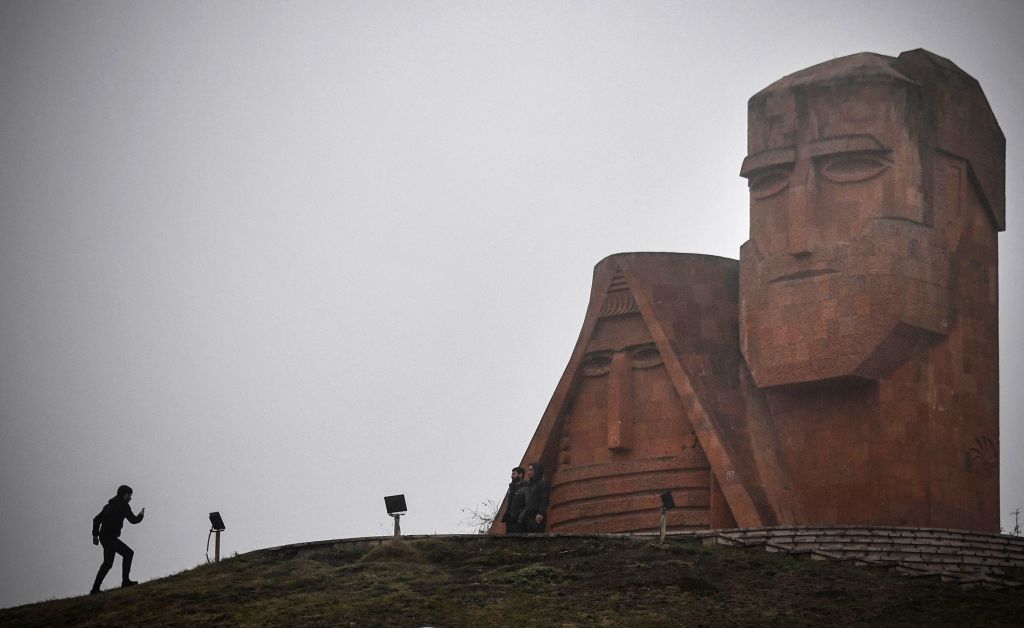
September 2023 saw the tumultuous and traumatic departure of over 100,000 Armenians from Nagorno-Karabakh. This mass exodus of an indigenous people from their homeland followed nine months of starvation-by-blockade, which culminated in a murderous military assault on Sept. 19.
These men, women, and children, terrified for their lives, left behind entire worlds: their schools and shops; their fields, flocks, and vineyards; the cemeteries of their ancestors. They also left behind the churches, large and small, ancient and more modern, magnificent and modest, where they had for centuries gathered together and prayed. They also left behind bridges, fortifications, early modern mansions, and Soviet-era monuments, such as the beloved “We are Our Mountains” statues. What will happen now to those places? There is no question, actually.
We know well what happened in Julfa, in Nakhichevan: a spectacular landscape of 16th-century Armenian tombstones was erased from the face the earth by Azerbaijan over a period of years. We know what happened to the Church of the Mother of God in Jebrayil and the Armenian cemetery in the village of Mets Tagher (or Böyük Taglar)—both were completely scrubbed from the landscape using earthmoving equipment like bulldozers. And we know what happened to the Cathedral of Ghazanchetsots in Shushi, which was, in turn, shelled, vandalized with graffiti, “restored” without its Armenian cupola, and now rebranded as a “Christian” temple. The brazenness of these actions, as journalist Joshua Kucera wrote in May 2021, “suggests a growing confidence that [Baku] can remake their newly retaken territories in whatever image they want.”
The annihilation of millennia of Armenian life in Arstakh was enabled by the inaction and seeming indifference of those who might have prevented it. The United States and the European Union speak loftily of universal human rights, but did nothing for nine months while the people of Arstakh were denied food, medicine, fuel, and other vital supplies. They did nothing to enforce the order of the International Court of Justice demanding back in February 2023 that Azerbaijan end its blockade. That inaction clearly emboldened Azerbaijan to attack—just as it will encourage others to do the same elsewhere.
More From TIME
Read More: The U.S. Keeps Failing Armenians in Nagorno-Karabakh
It’s important to understand the stakes of this kind of cultural erasure: These monuments and stones testify to the generations of Armenians who worshipped in and cared about them. To destroy them, is to erase not only a culture, but a people. As art historian Barry Flood observed in 2016 about the destruction of cultural heritage by the so-called Islamic state since 2014, “the physical destruction of communal connective tissues—the archives, artifacts, and monuments in which complex micro-histories were instantiated—means that there are now things about these pasts that cannot and never will be known.” The Julfa cemetery is a tragic example of such loss.
If history is any indication, ethnic cleansing tends to be followed by all kinds of cultural destruction, from vandalism to complete effacement from the landscape. The latter tactic will be used with smaller, lesser-known churches. It will be a sinister way to remove less famous Armenian monuments, which will serve the narrative that there were no Armenians there in the early modern period to begin with.
Falsification will also occur, in which Armenian monuments are provided with newly created histories and contexts. The 13th-century monasteries of Dadivank (in the Kalbajar district) and Gandzasar (in the Martakert province), both magnificent and characteristic examples of medieval Armenian architecture, have already been rebranded as “ancient Caucasian Albanian temples.” Expect these and other sites to become venues for conferences and workshops to highlight “ancient Caucasian Albanian culture.” As for the countless Armenian inscriptions on these buildings, khachkars, and tombstones: these, as President of Azerbaijan Ilham Aliyev announced in February 2021, are Armenian forgeries, and will be “restored” to their “original appearance” (presumably through gouging, sandblasting, or removing of Armenian inscribed stones, as was done in the 1980s).
Finally, there will be a celebration of the “multiculturalism” of Azerbaijan. “Come to Karabakh, home of ancient Christians,” people will say. “Please ignore the gouged-out letters on that stone wall, for it is not an Armenian inscription. There were never Armenians here!" Except for soldiers and invaders, like the ones depicted in a reprehensible museum in Baku, featuring waxen figures of dead Armenian soldiers—a sight so dehumanizing that an international human rights organizations, including Azerbaijani activists, cried out for its closure.
This is how cultural genocide plays out. A little more than 100 years ago was the Armenian Genocide waged by the Ottoman Empire, followed by largescale looting, vandalization, and destruction of Armenian sites across what is now modern-day Turkey. The prospect of a second cultural genocide is now on the table. Except now, Armenians will watch the spectacle unfold online, enduring the trauma site by site and monument by monument.
In 2020, Armenian activists called for international monitoring of vulnerable sites in Nagorno-Karabakh by UNESCO and other heritage organizations. Nothing happened. Now is the time for the world to protect what Armenian culture remains in Nagorno-Karabakh. If we don’t, what culture will be next to go?
Want more fresh perspectives? Sign up for TIME POV, our opinion newsletter.
The original version of this story misstated the president of Azerbaijan's name. It is Ilham Aliyev, not Ilhan Aliyev.
More Must-Reads from TIME
- Donald Trump Is TIME's 2024 Person of the Year
- TIME’s Top 10 Photos of 2024
- Why Gen Z Is Drinking Less
- The Best Movies About Cooking
- Why Is Anxiety Worse at Night?
- A Head-to-Toe Guide to Treating Dry Skin
- Why Street Cats Are Taking Over Urban Neighborhoods
- Column: Jimmy Carter’s Global Legacy Was Moral Clarity
Contact us at letters@time.com